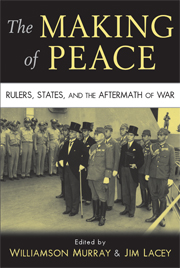Book contents
- Frontmatter
- Contents
- Preface: concluding peace
- 1 Introduction: searching for peace
- 2 The Peace of Nicias
- 3 “A swift and sure peace”: the Congress of Westphalia 1643–1648
- 4 The Peace of Paris, 1763
- 5 In search of military repose: the Congress of Vienna and the making of peace
- 6 War and peace in the post–Civil War South
- 7 Vae victoribus: Bismarck's quest for peace in the Franco-Prussian War, 1870–1871
- 8 Versailles: the peace without a chance
- 9 “Building buffers and filling vacuums”: Great Britain and the Middle East, 1914–1922
- 10 Mission improbable, fear, culture, and interest: peace making, 1943–1949
- 11 The economic making of peace
- 12 Ending the Cold War
- 13 Conclusion: history and the making of peace
- Index
- References
11 - The economic making of peace
Published online by Cambridge University Press: 05 June 2012
- Frontmatter
- Contents
- Preface: concluding peace
- 1 Introduction: searching for peace
- 2 The Peace of Nicias
- 3 “A swift and sure peace”: the Congress of Westphalia 1643–1648
- 4 The Peace of Paris, 1763
- 5 In search of military repose: the Congress of Vienna and the making of peace
- 6 War and peace in the post–Civil War South
- 7 Vae victoribus: Bismarck's quest for peace in the Franco-Prussian War, 1870–1871
- 8 Versailles: the peace without a chance
- 9 “Building buffers and filling vacuums”: Great Britain and the Middle East, 1914–1922
- 10 Mission improbable, fear, culture, and interest: peace making, 1943–1949
- 11 The economic making of peace
- 12 Ending the Cold War
- 13 Conclusion: history and the making of peace
- Index
- References
Summary
In December 2006, sixty-one years after the end of the Second World War, Britain sent a final payment of $87 million to the U.S. Treasury and thereby closed out its Second World War debt. Clearly, in the decades following the war, Britain had repaired its war-torn economy and even regained much of its former wealth. This happy circumstance periodically led to parliamentary discussions about using some of Britain's new wealth to pay off the loan early. However, the loan terms were so absurdly easy that the usual response mirrored that given by Lord McIntosh of Haringey to the House of Lords in 2001, “The basis of the loan is that interest is paid at two percent. Therefore, we are currently receiving a greater return on our dollar assets then we are paying in interest to pay off the loan. It is a very advantageous loan for us.” In other words, as early as the 1960s, the loan was more than paying for itself. In effect, it was even adding cash to the British Treasury.
A Britain prosperous enough to even consider early repayment of its war loans, which constituted a significant portion of the United Kingdom's gross domestic product when they were made, was by no means a foregone conclusion in 1945. In fact, as the war ended, Britain was bankrupt, while the remainder of war-ravaged Europe was in even worse condition.
- Type
- Chapter
- Information
- The Making of PeaceRulers, States, and the Aftermath of War, pp. 293 - 322Publisher: Cambridge University PressPrint publication year: 2008

